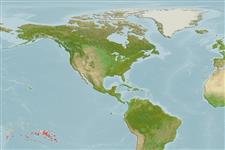Common names from other countries
Environment: milieu / climate zone / depth range / distribution range
Ekologi
marina revassocierade; ej vandrande; djupintervall 40 - 100 m (Ref. 89972). Subtropical
Eastern Pacific: Cook Islands to Ducie Atoll (Pitcairn).
Size / Vikt / Age
Maturity: Lm ? range ? - ? cm
Max length : 35.0 cm TL hane/ej könsbestämd; (Ref. 4858)
Inhabits rock and coral reef at depths of 30 to at least 60 m. Occurs in aggregations that swim high above the bottom; harems of 2-5 individuals. Feeds mainly on zooplankton, although some benthic material is probably consumed (Ref. 4858). Almost never exported through the aquarium trade (Ref. 48391).
Life cycle and mating behavior
Maturities | Reproduktion | Spawnings | Egg(s) | Fecundities | Larver
Allen, G.R., 1985. Butterfly and angelfishes of the world. Vol. 2. 3rd edit. in English. Mergus Publishers, Melle, Germany. (Ref. 4858)
IUCN Red List Status (Ref. 130435)
CITES (Ref. 128078)
Not Evaluated
Threat to humans
Harmless
Human uses
Verktyg
Special reports
Download XML
Internet-källor
Estimates based on models
Preferred temperature (Ref.
115969): 25.1 - 28.4, mean 27.4 (based on 133 cells).
Phylogenetic diversity index (Ref.
82804): PD
50 = 0.5010 [Uniqueness, from 0.5 = low to 2.0 = high].
Bayesian length-weight: a=0.03090 (0.01359 - 0.07026), b=2.89 (2.70 - 3.08), in cm Total Length, based on LWR estimates for this (Sub)family-body shape (Ref.
93245).
Trofisk nivå (Ref.
69278): 3.4 ±0.45 se; based on food items.
Resiliens (Ref.
120179): Mellan, lägsta populationsfördubblingstid 1,4-4,4 år (Preliminary K or Fecundity.).
Fishing Vulnerability (Ref.
59153): Low vulnerability (25 of 100).
